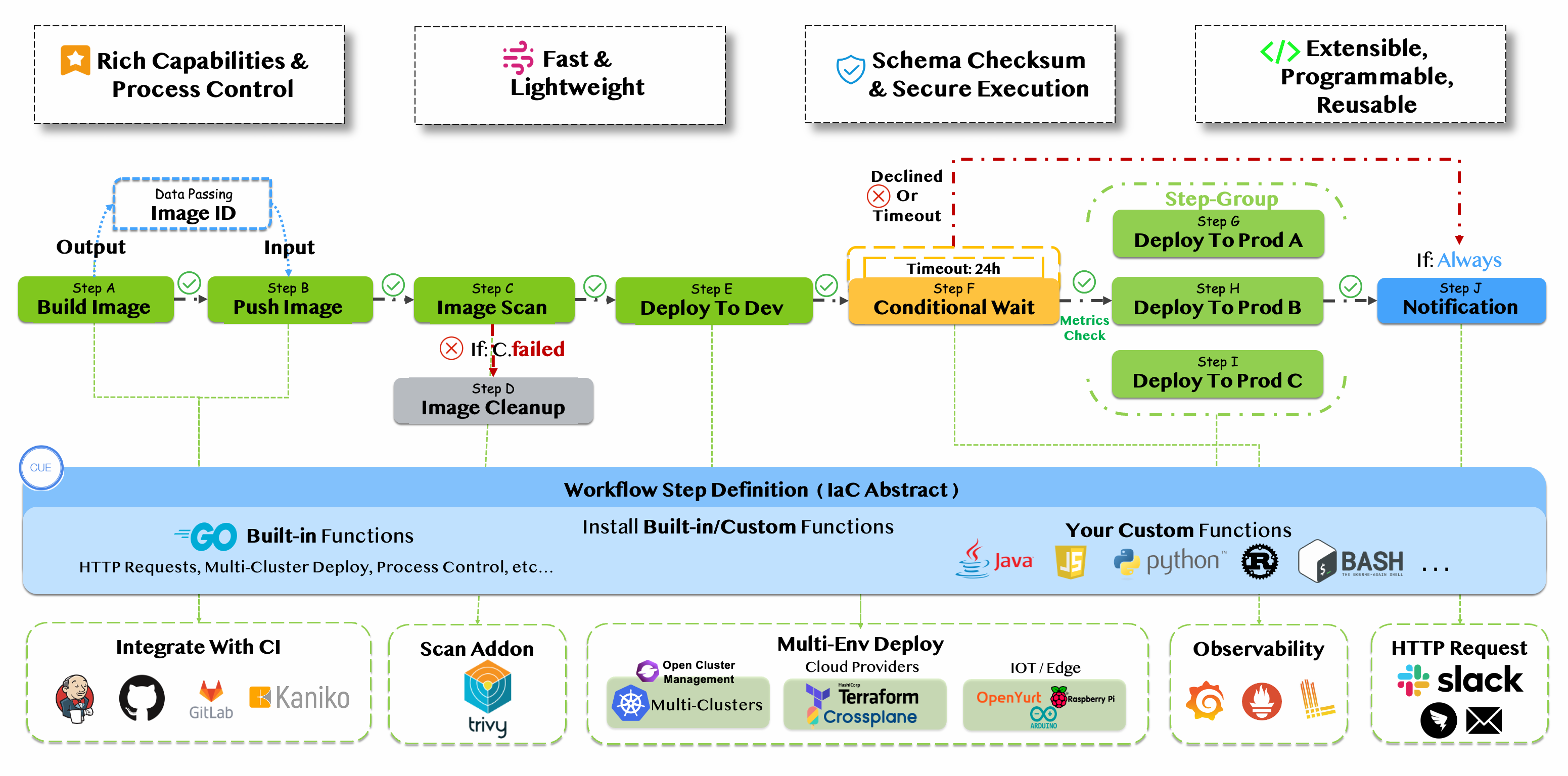KubeVela Workflow




What is KubeVela Workflow
KubeVela Workflow is an open-source cloud-native workflow project that can use to orchestrate CI/CD process, terraform resources, multi-kubernetes-clusters management and even your own functional calls.
You can install KubeVela Workflow and use it, or import the code as an sdk of an IaC-based workflow engine in your own repository.
The main differences between KubeVela Workflow and other cloud-native workflows are:
All the steps in the workflow is based on IaC(Cue): every step has a type for abstract and reuse, the step-type is programmed in CUE language and easy to customize.
That is to say, you can use atomic capabilities like a function call in every step, instead of just creating a pod.
Why use KubeVela Workflow

🌬️ Lightweight Workflow Engine: KubeVela Workflow won't create a pod or job for process control. Instead, everything can be done in steps and there will be no redundant resource consumption.
✨ Flexible, Extensible and Programmable: Every step has a type, and all the types are based on the CUE language, which means if you want to customize a new step type, you just need to write CUE codes and no need to compile or build anything, KubeVela Workflow will evaluate these codes.
💪 Rich built-in capabilities: You can control the process with conditional judgement, inputs/outputs, timeout, etc. You can also use the built-in step types to do some common tasks, such as deploy resources, suspend, notification, step-group and more!
🔐 Safe execution with schema checksum checking: Every step will be checked with the schema, which means you can't run a step with a wrong parameter. This will ensure the safety of the workflow execution.
Try KubeVela Workflow
Run your first WorkflowRun to distribute secrets, build and push your image, and apply the resources in the cluster! Image build can take some time, you can use vela workflow logs build-push-image --step build-push to check the logs of building.
apiVersion: core.oam.dev/v1alpha1
kind: WorkflowRun
metadata:
name: build-push-image
namespace: default
spec:
workflowSpec:
steps:
# or use kubectl create secret generic git-token --from-literal='GIT_TOKEN=<your-token>'
- name: create-git-secret
type: export2secret
properties:
secretName: git-secret
data:
token: <git token>
# or use kubectl create secret docker-registry docker-regcred \
# --docker-server=https://index.docker.io/v1/ \
# --docker-username=<your-username> \
# --docker-password=<your-password>
- name: create-image-secret
type: export2secret
properties:
secretName: image-secret
kind: docker-registry
dockerRegistry:
username: <docker username>
password: <docker password>
- name: build-push
type: build-push-image
properties:
# use your kaniko executor image like below, if not set, it will use default image oamdev/kaniko-executor:v1.9.1
# kanikoExecutor: gcr.io/kaniko-project/executor:latest
# you can use context with git and branch or directly specify the context, please refer to https://github.com/GoogleContainerTools/kaniko#kaniko-build-contexts
context:
git: github.com/FogDong/simple-web-demo
branch: main
image: fogdong/simple-web-demo:v1
# specify your dockerfile, if not set, it will use default dockerfile ./Dockerfile
# dockerfile: ./Dockerfile
credentials:
image:
name: image-secret
# buildArgs:
# - key="value"
# platform: linux/arm
- name: apply-deploy
type: apply-deployment
properties:
image: fogdong/simple-web-demo:v1
Quick Start
After installation, you can either run a WorkflowRun directly or from a Workflow Template. Every step in the workflow should have a type and some parameters, in which defines how this step works. You can use the built-in step type definitions or write your own custom step types.
Please checkout the WorkflowRun Specification and WorkflowRun Status for more details.
Run a WorkflowRun directly
For more, please refer to the following examples:
Run a WorkflowRun from a Workflow Template
Please refer to the following examples:
Installation
Install Workflow
Helm
helm repo add kubevela https://kubevela.github.io/charts
helm repo update
helm install --create-namespace -n vela-system vela-workflow kubevela/vela-workflow
KubeVela Addon
If you have installed KubeVela, you can install Workflow with the KubeVela Addon:
vela addon enable vela-workflow
Install Vela CLI(Optional)
Please checkout: Install Vela CLI
Features
Step Types
Built-in Step Types
Please checkout the built-in step definitions with scope that valid in WorkflowRun.
Write Your Custom Step Types
If you're not familiar with CUE, please checkout the CUE documentation first.
You can customize your steps with CUE and some built-in operations. Please checkout the tutorial for more details.
Note that you cannot use the application operations since there're no application data like components/traits/policy in the WorkflowRun.
How can KubeVela Workflow be used
During the evolution of the OAM and KubeVela project, workflow, as an important part to control the delivery process, has gradually matured. Therefore, we separated the workflow code from the KubeVela repository to make it standalone. As a general workflow engine, it can be used directly or as an SDK by other projects.
As a standalone workflow engine
Unlike the workflow in the KubeVela Application, this workflow will only be executed once, and will not keep reconciliation, no garbage collection when the workflow object deleted or updated. You can use it for one-time operations like:
- Glue and orchestrate operations, such as control the deploy process of multiple resources(e.g. your Applications), scale up/down, read-notify processes, or the sequence between http requests.
- Orchestrate delivery process without day-2 management, just deploy. The most common use case is to initialize your infrastructure for some environment.
As an SDK
You can use KubeVela Workflow as an SDK to integrate it into your project. For example, the KubeVela Project use it to control the process of application delivery.
You just need to initialize a workflow instance and generate all the task runners with the instance, then execute the task runners. Please check out the example in Workflow or KubeVela.
Contributing
Check out CONTRIBUTING to see how to develop with KubeVela Workflow.
 Directories
¶
Directories
¶


